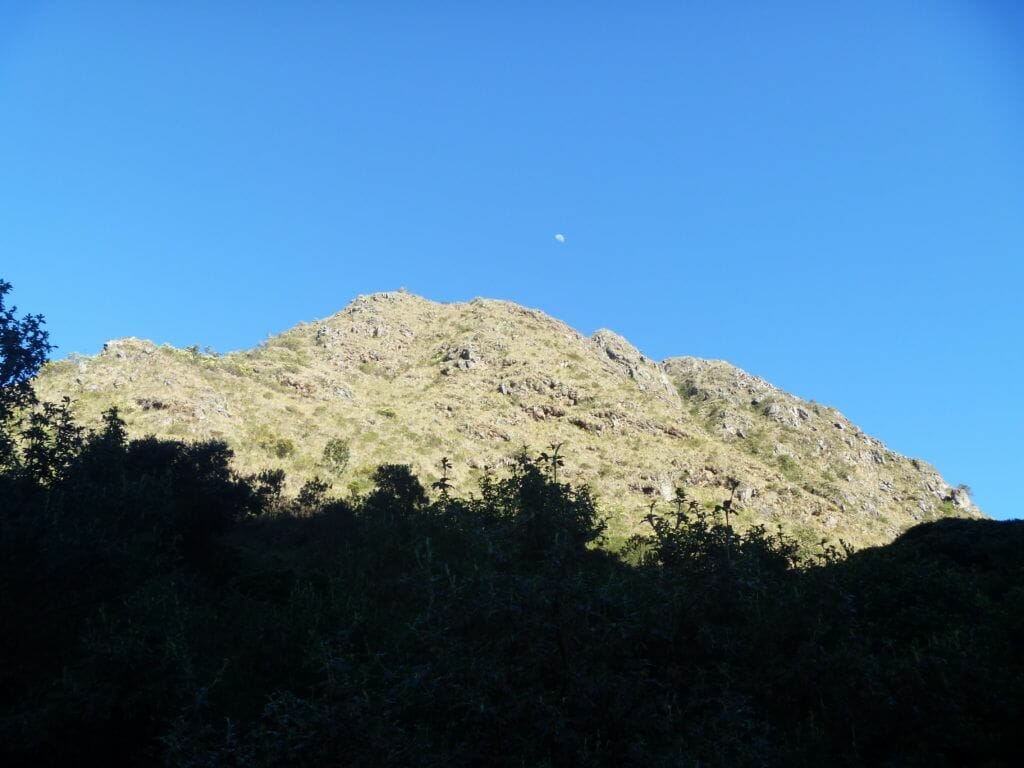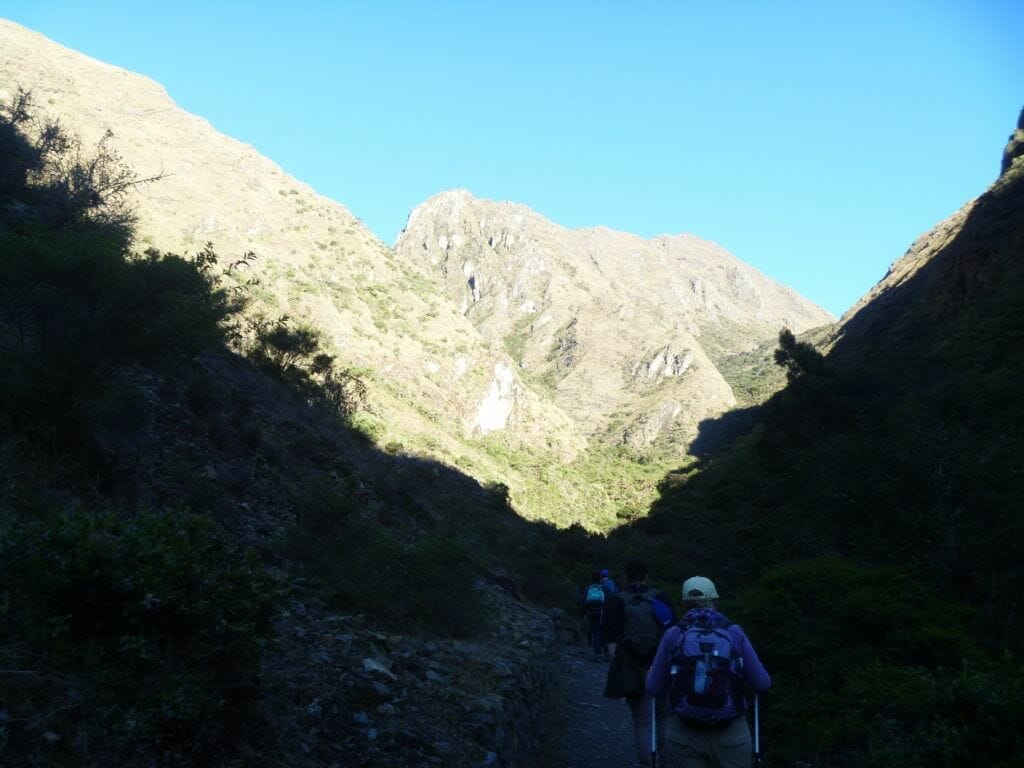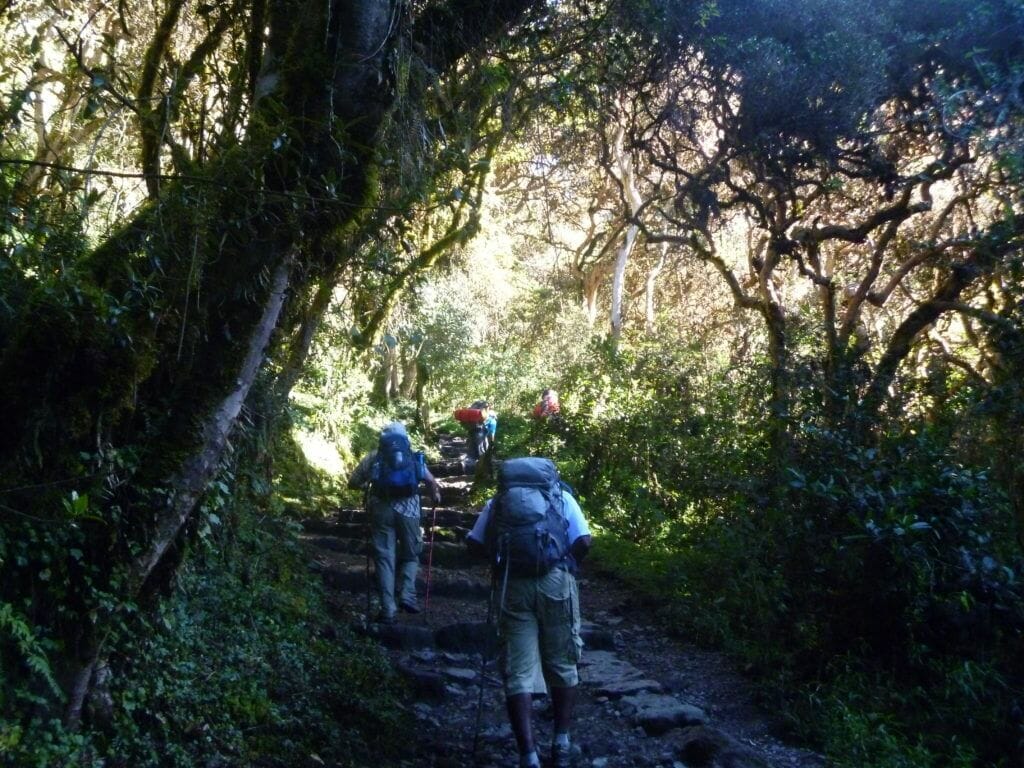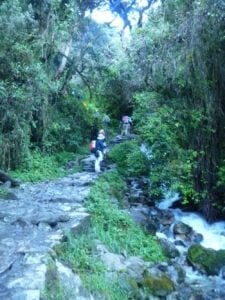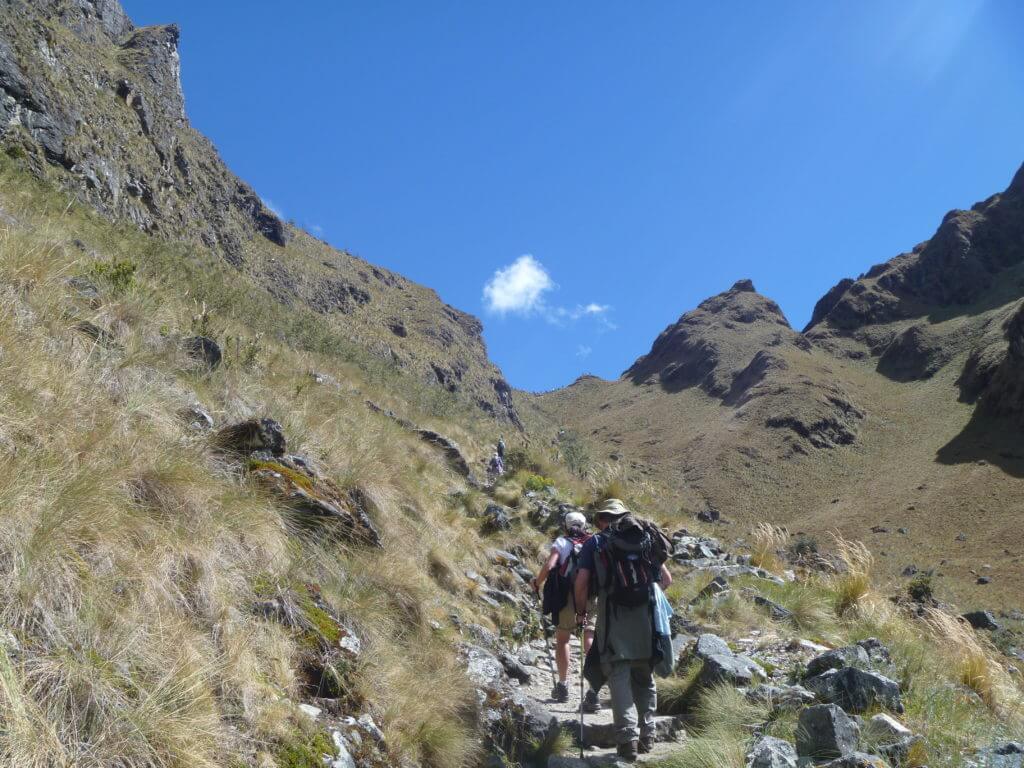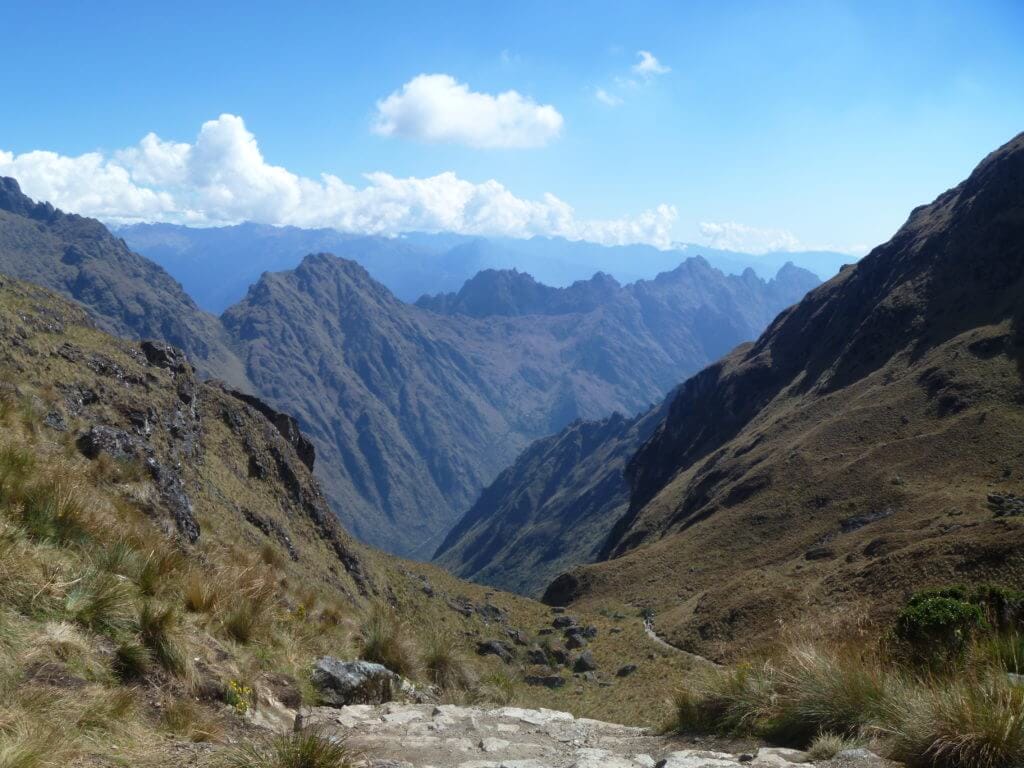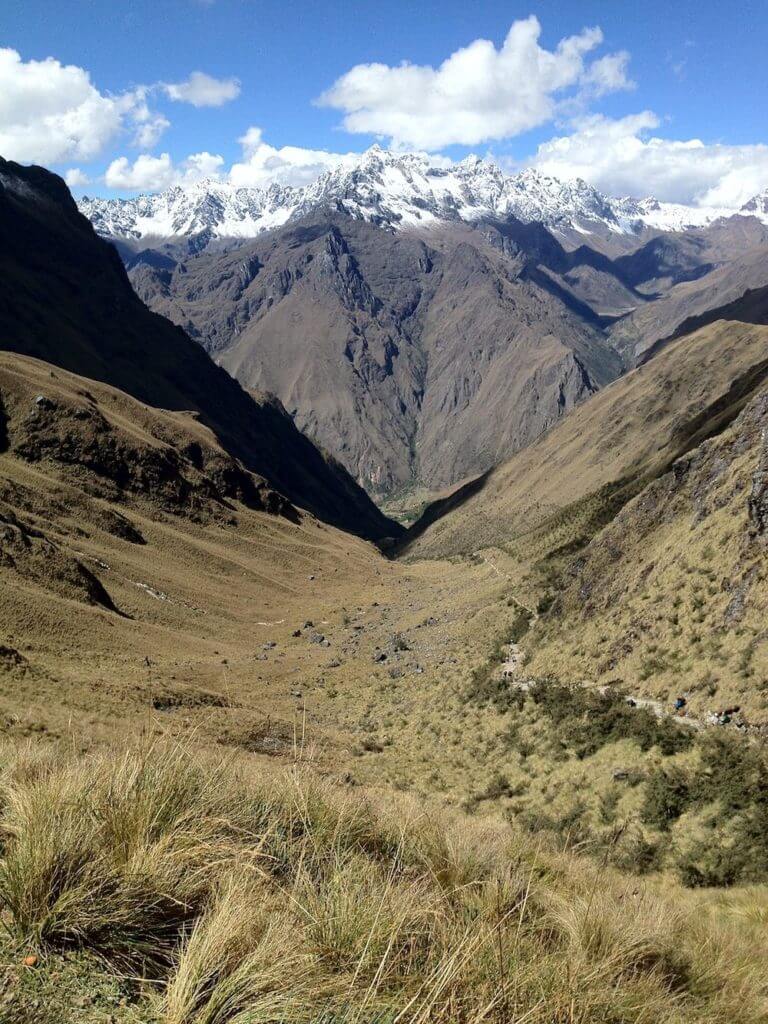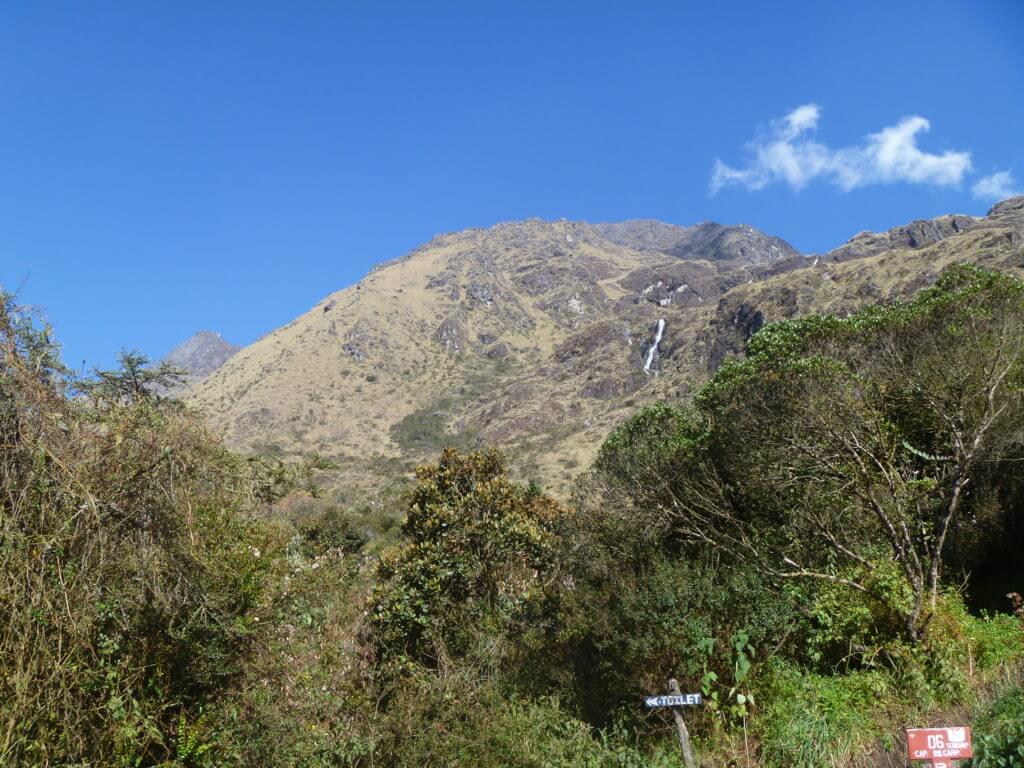Opening my eyes I could tell it was early but I had been lying here for the last 20 minutes and it was time to move. The mountain peaks still hid the sun from the valley. Without its warm glow there was a definite chill in the air as I unzipped my tent, momentarily struggling for a breath, but it gave me something else to focus on apart from the jackhammer currently doing a very painful rendition of Survivor’s “Eye Of The Tiger” in my head thanks to last nights festivities. Clearly, enjoying a beverage at altitude was going to be harder going than I had anticipated.
With our camp sitting at 3,000m we knew we were going to be in for a tough day. Day 2 on the Inca Trail is widely regarded as the toughest of all the days. This mornings challenge is getting up to, and over the highest point on the trek, Warmiwañusca, also referred to as Dead Woman’s Pass at 4,200m (13,860ft), because of the profile the mountains it looks like a woman lying on her back. While the going is steep and gets gradually steeper as you ascend it’s not that unbearable. The key to surviving the altitude it so take it slow and steady. By the end of today’s 12km trek you will have gained 1200m in altitude then lost 2000m to get to the next camp at Paqaymayo.
First we had the pleasure of breakfast. Quinoa porridge is something I have grown to love from my time on the trek. In fact all things made with quinoa. I hadn’t even heard of it before I had arrived in Peru and now it seemed like it was all we were eating. What the chefs do with a little 2 ring stove, a couple of pots and some water is nothing short of a miracle.
Quinoa is a healthy staple addition to all meals for the people of Peru and surrounding countries. Made of maize you would be as surprised as I was to find out what you can actually do with it. During our time on the trail, along with my favourite porridge in the mornings the chefs used it to create delicious soups, salads, stews and even quinoa con leche for a healthier pudding.
In the mess tent we were all eagerly awaiting our breakfast to arrive while tucking in to the powdered coffee and biscuits that had already been laid out for us by the porters who were currently beavering away outside dismantling the camp around us ready to head off as soon as we had finished breakfast to beat the crowds up the mountain.
Breakfast over with and bags on it was time to step further into the unknown. The path out of camp lulling us into a false sense of security by slowly meandering northwards with no gradient. The flat path didn’t, unfortunately, last all that long out of camp, instead giving way to steps that led us up into the dense foliage above camp.
Steps were to be the theme of the morning. Every time we finished a set of killer steps with thighs that could, by then, crack walnuts, the trail would turn another corner and present even more for our thighs to scream at. At the meeting we had over dinner the night before we knew today was going to be tough but this was beyond what we all thought we would be enduring.
It would take the better part of 3 painful hours to clear the tree line which, we thought, signalled our imminent arrival at the top. Instead, clearing the last tree, we saw the brightest of blue skies above us and nothing but mountain peak after mountain peak all around us. My heart sank as, squinting in the bright glow of mid morning, my eye line followed the never ending trail snaking its way up to what was clearly the top.
It was so damn far away and so much higher left to go. My legs were about to divorce the rest of my body now I had to present them with this. Squatting on a rock I finished off the rest of my morning snack box helpfully provided to us by the chef. He must have known what we would be thinking by this point in the day because every box contained a piece of fruit, a chicken leg wrapped in foil, a carton of juice and a packet of biscuits. Luckily I had left the biscuits until last.
Putting the now empty biscuit wrapper in my bag I stood up and steeled myself for what looked at least another hour on a stair master 5 million. Rucksack back on my back I turned to face the mountain for one last 600 vertical meter push through the meadow that is known as Llulluchapampa.
Underestimating the effect of the high altitude we were now at, the last step that took me up and over the summit was not until 90 minutes after I started my ‘final push’ and so many pit stops along the way for water, air, to rest or contemplate getting some new lungs because I was sure that mine were defective.
Standing on the small plateau on top of the proverbial Dead Woman I felt a sense of achievement. 4200 meters above sea level the air felt so fresh against my exposed face. It smelt clean. I had never been as high as this in my life and the sense of pride in myself, in what I could do when I truly put my mind to it was truly satisfying.

Finally standing on top of Dead Woman Pass with snow capped peaks above us, the views are as incredible as we were promised.
Then there was the view. We were promised stunning views once we got to the top but this was on another level entirely. Looking down over the valley we had just clambered up it was hard at first to comprehend we had done all this in 5-6 short hours. Above us the cragged peaks with fresh snow clinging to them was tantalisingly close yet frustratingly out of reach thanks to the sheer cliffs. Here we were standing in t-shirts and bright sunshine while a mere 200ft or so above us the snow line was clearly visible.
Spreading out like a spine below us were yet more rocky peaks, this time green, covered in trees clinging perilously to their sheer sides. The trail snaked its way down from our viewpoint finally disappearing over what looked like a precipitous drop off.
Looking back the way we had come, hikers were still making their last painful steps up the trail. The snow capped peak of Mount Veronica proudly looked over us with the valley drawing our gaze to the breathtaking backdrop.

Looking up towards the peak we follow the cascading waterfall all the way down to our camp at Paqaymayo.
It took a good 30 minutes for everyone in our group to make it to the top giving us plenty of time to soak up the views and get some very well earned rest. The weather gods were with us for the duration of our trek but depending on the time of year, the weather on the exposed plateau ranges from blazing hot sunshine to a windswept desolate peak so make sure you have a couple of layers in your day pack just in case the famously changeable Andean weather decides not to play fair.
From the top of dead woman’s pass it is a further 2 hour hike to reach camp. After nearly an hour at the top with everyone rested it was time for us to make our descent. Now 9km in and with only 3km to go I mistakenly thought that this afternoon would be a breeze.
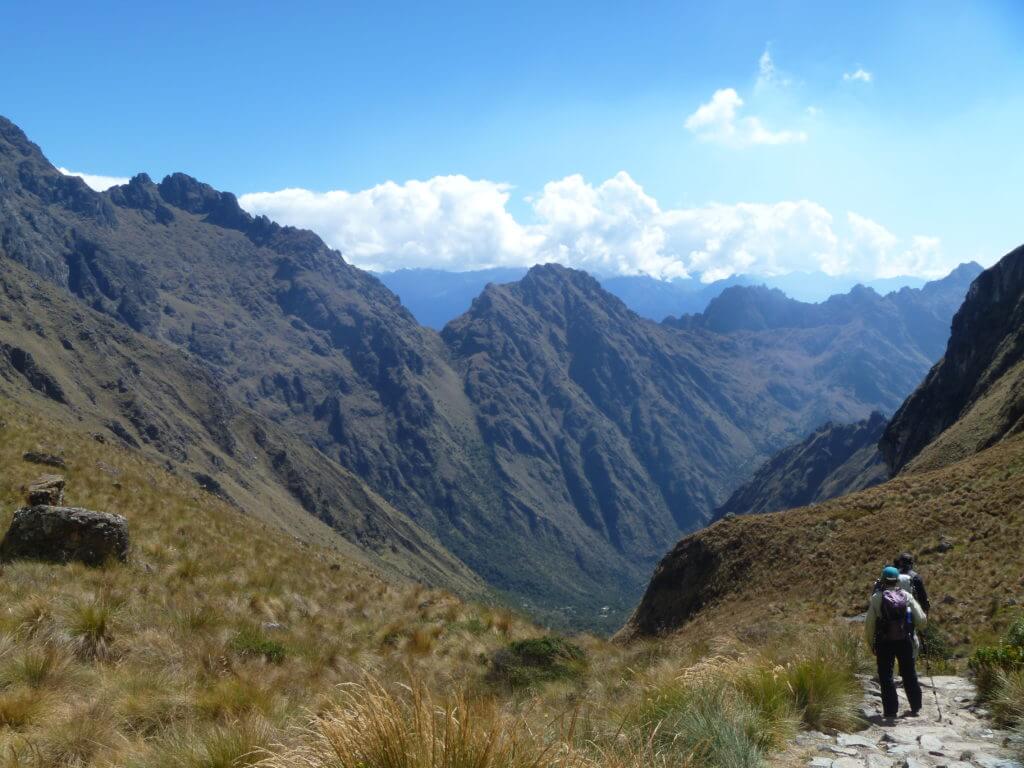
Hikers taking a moment to admire the view on the way down from Dead Womans Pass. You can just make out Paqaymayo camp in the valley.
The steps down the pass are steep so take things steady. If you have walking sticks now is a good time to crack them out. If you decided to purchase some coke leaves at one of the stalls on your way through yesterday or bought some in Cuzco before you started out they will certainly help with the flagging energy levels.
Coke leaves, as many people refer to them, are probably one of the more infamous things easily accessible in Peru. Don’t associate them with the highly refined black market white powder that comes from the same cocoa plant and is just as illegal in Peru as it is in every other country worldwide. The cocoa plant itself is well renowned for its medicinal properties, in particular being very good at alleviating the effects of altitude and providing a natural energy boost. You will see people everywhere chewing on the leaves and it is very cheap to buy and available everywhere from supermarkets to small food stalls.
Incredibly bitter to taste it is not for everyone but if you want to try some have a word with your guides who will probably be more than happy to let you try a few of their own supply. At first try only a few leaves, roll them in a ball and place at the back of your mouth and chew. When you’re finished spit out the leaves and replace with more or keep adding to what you already have.
Running on empty after using all my energy to ascend that morning, the coke leaves provided by our deputy guide got me through the afternoon. Going up was hard but the uneven surfaces and varying heights in the steps made this afternoon far more taxing than it should have been. By the time we arrived in camp just gone 3 I was mentally frazzled, exhausted and in need of 2 new knees.
Paqaymayo Camp sits in a beautiful valley surrounded on all sides by towering green cliffs. A stunning cascading waterfall off one cliff provides a great photo opportunity but you will first probably need a sit down and some rest before exploring camp. Don’t leave it too long though, the sun sets quick over the valley and sunset is a great time to capture the beauty of the valley that will be your home for the next 15 hours.
Just before dinner our enterprising young local appeared with tonight’s supply of beer. Gladly handing over a small up charge on the normal price in town we happily stood outside and watched the sun set casting the valley in the shadow of night as the bell finally rang that signalled the start of tonight’s quinoa inspired feast.
Tired yet elated, we had made it through the toughest part of the trek. Now we could enjoy the 2 days that remained without the burden of worry we had been carrying over today’s physical exertion. Day 3, however proved to be beyond all our expectations before we even stopped for lunch with what I still regard as the most beautiful vistas I have ever encountered.
Day 3 was to be unforgettable.

With high peaks around us, Paqaymayo Camp’s setting is beautiful. Prepare for it to cloud over in the early evening.
 Copyright secured by Digiprove © 2016
Copyright secured by Digiprove © 2016

